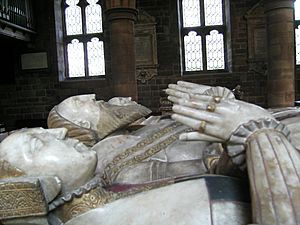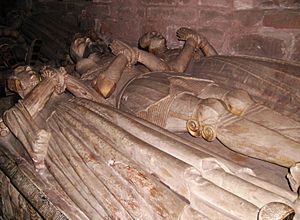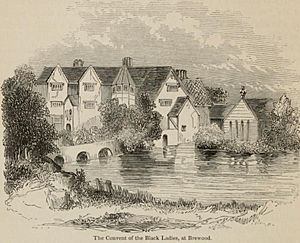Black Ladies Priory facts for kids
Black Ladies Priory was a home for Benedictine nuns (women who dedicate their lives to God) in Staffordshire, England. It was located about 4 kilometers west of Brewood, near a small village called Kiddemore Green. The priory was started in the mid-1100s.
It was a small priory and often struggled to make enough money. In 1538, during the time when many monasteries were closed down (called the Dissolution of the monasteries), Black Ladies Priory was shut. After it closed, a large house was built on the site by the Giffard family. This house, which mixes old English styles (Tudor and Jacobean), is still there today and is a private home called Black Ladies. It's considered a very important historical building.
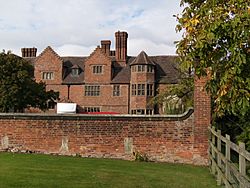
Black Ladies today: a large private residence incorporating 16th and 17th century structures erected by the Giffard family after the dissolution of the priory.
|
|
| Monastery information | |
|---|---|
| Full name | Convent of St. Mary of the Black Ladies |
| Other names | Community of the Black Nuns at Brewood |
| Order | Benedictine |
| Established | Mid-12th century |
| Disestablished | 1538 |
| Dedicated to | Mary, mother of Jesus |
| Diocese | Diocese of Coventry and Lichfield |
| Controlled churches | Broome, Worcestershire Possibly Rode, Somerset |
| People | |
| Founder(s) | Possibly Roger de Clinton |
| Important associated figures |
|
| Site | |
| Location | Near Brewood |
| Coordinates | 52°40′53″N 2°13′38″W / 52.6815°N 2.2271°W |
| Public access | no |
|
Listed Building – Grade II*
|
|
| Official name: Black Ladies | |
| Designated: | 16 May 1953 |
| Reference #: | 1039336 |
|
Listed Building – Grade II*
|
|
| Official name: Garden walls to east, north and south of Black Ladies, with gate piers | |
| Designated: | 16 May 1953 |
| Reference #: | 1039337 |
|
Listed Building – Grade II
|
|
| Official name: Tudor Barn, Blackladies | |
| Designated: | 28 March 1985 |
| Reference #: | 1374042 |
Contents
Why "Black Ladies"?
The priory was dedicated to St. Mary, the mother of Jesus. But people often called it "Black Ladies." The nuns who lived there wore black robes, which were called habits.
There was another priory nearby called White Ladies Priory. That one was for Augustinian nuns, who wore white habits. Both priories were founded around the same time and were similar in size. So, calling them "Black Ladies" and "White Ladies" helped people tell them apart!
The official name of the priory changed over time. A seal from the 1300s said "Convent of St. Mary of the Black Ladies." Later, a seal from 1538 said "Community of the Black Nuns at Brewood." But the dedication to the Virgin Mary always stayed the same.
How it Started
Black Ladies Priory was built on land that belonged to the Bishop of Coventry and Lichfield. It's thought that one of the bishops, Roger de Clinton, might have founded it. He was a powerful person in the mid-1100s and had also founded another small priory dedicated to St. Mary.
Even though we don't have clear proof of who founded it, we know it existed by the mid-1100s. A local landowner, Ralph Bassett, gave some land to the nuns around that time.
Later, between 1227 and 1241, Pope Gregory IX took the priory under his protection. This meant he supported them and confirmed their right to own land. He also said the nuns could choose their own leader, called a prioress.
Money and Land
The priory was never rich. Most of its money came from small pieces of land. These lands were often scattered around Staffordshire and nearby counties. The nuns worked hard to make the most of what they had. For example, they would exchange small, less useful pieces of land for better ones.
In 1200, King John gave the nuns the manor of Broome. This included the right to choose the priest for the church there, which was a valuable asset. The priory kept this right.
Kings also gave small gifts. In 1204, King John gave money to several small religious communities, including Black Ladies. Henry III also gave them wood from royal forests. One time, in 1241, he gave them a mark (a type of money) so they could get back their chalice (a special cup used in church services), which they had pawned because they were so poor!
Around the late 1200s, another priory called Blithbury, which had been connected to Black Ladies, seems to have joined it. Blithbury's lands then became part of Black Ladies' income.
In 1291, Pope Nicholas IV offered a special "indulgence" to people who visited Black Ladies on certain feast days. This meant visitors could reduce their penance (punishment for sins) by a year and forty days. This was a big reason for people to visit and bring offerings, which could help the priory's income.
Even with these efforts, the nuns were still quite poor in the early 1300s. They even had a disagreement with the local priest about who should get money from the wool of animals grazed on their land. However, by 1333, their taxes to the king were higher, suggesting they were doing a bit better.
In 1394, the prioress, Petronilla, received a very large gift of £100. This money was meant to set up a chantry, which was a fund to pay for prayers for a specific person after they died. This was the biggest gift the priory ever received.
A bishop named Northburgh visited the priory around 1323. He found that the priory's money was not being managed well. He made rules about how money, clothing, and food could be given out. He even fired two senior staff members who managed the food and the estates. He also stopped new people from joining the priory and told the prioress not to take bribes from those who wanted to join.
The bishop also had to remind the nuns about their basic rules:
- They should live simply.
- They should be pure.
- They should obey their leaders.
He found that one nun was keeping rental income for herself and ordered her to share it with everyone. The prioress was told to eat in the dining hall and sleep in the dormitory with the other nuns. No lay people (non-nuns) were allowed to sleep in the convent. Nuns were not supposed to talk to outsiders or leave the priory without a good reason.
Despite these problems, a visit in 1521 found the priory in good order. It had no debts, and its income was about £20. By 1535, just before the monasteries were closed, the priory's income was recorded as £11 1s. 6d. This amount seems incomplete, as other records show more income from places like Blithbury and Broome. The total income in 1537 was £17 2s. 11d.
This amount was considered very small. It was below the £200 limit set by the king for closing smaller monasteries. So, the closing of Black Ladies Priory was expected, simply because it wasn't wealthy enough.
Life as a Nun
The community of nuns at Black Ladies was very small. When the priory closed in 1538, there were only three nuns and the prioress. A visit in 1521 also found only four nuns living there. It seems there were never more than a few nuns at a time.
However, they had several lay servants and officials who helped them. At the time of the closing, a chaplain (a priest) and seven other employees had to be paid off. Besides money problems, the priory also seemed to have trouble with its management.
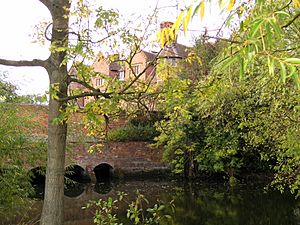
An interesting story from 1286 shows some of their struggles. A deer escaped from the royal forest and drowned in the priory's fishpond. A local landowner, John Giffard, pulled the deer out and claimed it. He took half, leaving the rest for the nuns. This was a serious offense at the time. When the case went to court, John Giffard was fined. But for the nuns, the judge said: "as they are poor, they are pardoned for the good of the king’s soul." This shows how poor they were.
Bishops had to step in three times in the 1400s to appoint a prioress because the position was empty for too long. Nuns were supposed to elect their own leader. However, the visit in 1521 found the priory to be well-run, though one nun mentioned that young girls slept in the dormitory with the nuns.
Leaders of the Priory (Prioresses)
Here are some of the prioresses who led Black Ladies Priory:
- Isabel lived around 1258-1295.
- Mabel or Amabilia was active in 1272 and 1275.
- Emma was prioress in 1301.
- Alice de Swynnerton was prioress until she resigned in 1332.
- Helewis of Leicester was elected in 1332 and was still alive in 1373.
- Parrnel or Petronilla received a large gift in 1394 and was still alive in 1412.
- Margaret Chilterne was appointed in 1442 and resigned by 1452.
- Elizabeth Botery was appointed by the bishop in 1452 and died in 1485.
- Margaret Cawardyn was appointed in 1485.
- Isabel Lawnder was prioress by 1521 and stayed until the priory closed in 1538. She later lived with her sister.
Closing Down and Sale
Black Ladies Priory was one of the smaller monasteries chosen to be closed. The prioress at the time was Isabel Lawnder. Local landowners were very interested in buying the site. One of them was Edward Littleton, who had made a lot of money by buying church lands.
However, on October 11, 1538, the lease for the priory was given to Thomas Giffard. He was a gentleman who worked for the king and was the son of Sir John Giffard of Chillington Hall.
On October 16, 1538, Thomas Legh, who was in charge of closing down monasteries, officially took over Black Ladies from Prioress Isabel. She received a payment of 40 shillings and an annual pension of £3 6s. 8d. The other three nuns each received half of that amount. The priory's eight servants, including the chaplain, were also paid off.
The priory's belongings were then sold off. Thomas Giffard bought them for a total of £7 6s. 1d., which was a very small amount. These items included three bells from the church tower, a silver chalice, spoons, a horse, and farm equipment.
Even though Giffard had the lease, Edward Littleton had also been promised the property. So, Legh put both Giffard and Littleton in charge until the king made a final decision. In the end, Giffard won. In February 1539, he bought the priory site, its watermill, lands, church, and steeple for £134 1s. 8d.
What Happened Next
After Thomas Giffard's father died in 1556, Black Ladies became part of the Giffard family's main estates. Thomas Giffard first gave Black Ladies to his younger son, Humphrey. But after Humphrey died, it went to Thomas's oldest son, John.
Today, the house called Black Ladies still stands. It includes parts of the buildings that the Giffard family built in the late 1500s and early 1600s, after the priory was closed. There were also other buildings like stables, which are now a separate house called Tudor Barn.
During the time of the Commonwealth (when England was a republic), the Giffards temporarily lost Black Ladies. This was because they supported the king during the English Civil War. From the early 1700s, parts of Black Ladies were rented out. In 1893, it was finally sold to Major Ernest Vaughan.
The Giffard family remained Catholic for over 300 years, even after England became Protestant under Elizabeth I. They were leaders of the Catholic community in the Brewood area and protected their Catholic tenants. Their chapel at Chillington Hall was used for worship.
Until about 1846, Black Ladies also had a family chapel. When the Chillington chapel was being repaired in the 1700s, worship moved to the chapel at Black Ladies and continued there until 1844. This chapel was thought to be older than the main house and built from stones from the old priory. In 1844, a new Catholic church was built in Brewood, also dedicated to St. Mary.
This new church has an "ancient" statue of the Madonna and Child. It's believed that this statue was damaged by a sword during a search of Black Ladies by soldiers during the escape of Charles II. People used to believe that the "wound" on the statue would "weep" and that the liquid could cure illnesses. The statue looks like it's from the 1600s, so it was likely part of the Giffards' chapel, not the original priory.
|




